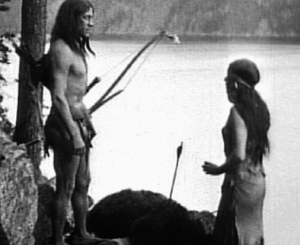 The movie is shot in documentary style and shows a tribe of Ojibwe (from Canada) as they go about their daily lives. There is a boy who spears a fish, a girl who snares a partridge by using a long stick with a noose attached to it, a pair of pet bear cubs (captured after the mother was killed), the breaking down of camp and traveling with sleds pulled by dogs. the discovery of a cache of food left by another tribe and the hunt for food to ensure the survival of the band through the brutal winter.
The movie is shot in documentary style and shows a tribe of Ojibwe (from Canada) as they go about their daily lives. There is a boy who spears a fish, a girl who snares a partridge by using a long stick with a noose attached to it, a pair of pet bear cubs (captured after the mother was killed), the breaking down of camp and traveling with sleds pulled by dogs. the discovery of a cache of food left by another tribe and the hunt for food to ensure the survival of the band through the brutal winter.
Baluk had no luck when he took a party of hunters to the south for over a month. Baluk proposes that the band move to the north to intercept the annual caribou migration. Medicine man Dagwan says the the band should stay where they are and the Great Spirit will provide but chief Chetoga decides to follow Baluk's advice. If the plan fails Dagwan says Baluk must take the blame.
The journey is long and brutal and Chetoga does not make it. The dogs are crazed with hunger and a wolverine and a mounyain lion fight over the last of their food supply. The Silent Enemy (hunger) may destroy the tribe.
There are a lot of things I really liked about this movie. Being silent there was no broken English. There were also real Indian actors (mostly amateur). There were some great scenes of every day life amongst the tribes. And this may be the only movie about American Indians in a time period before the arrival of Columbus. A really good movie, well worth seeing.
It's a shame that W. Douglas Burden, who wrote and produced this movie didn't get involved in any more movies. He was a rich New Yorker and Vanderbilt family heir, In 1926, he journeyed to Komodo Island to hunt its giant lizards he called Komodo Dragons. He brought back two live specimens for The Bronx Zoo and twelve dead ones for the American Museum of Natural History, where three are still on display. He told his story to his friend Merian C. Cooper who retold the story changing the giant lizard into a giant ape, and called it King Kong (1933).
|